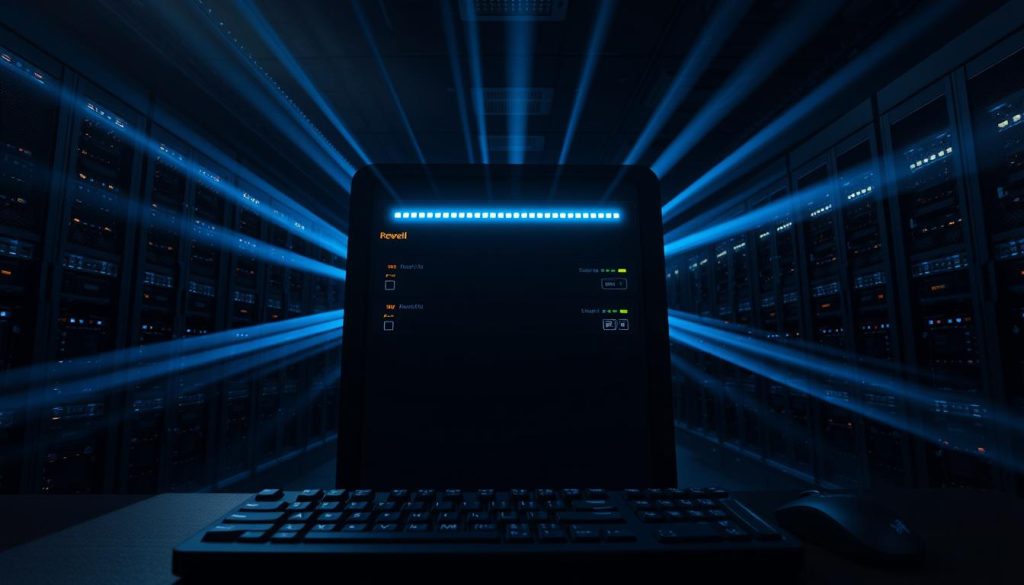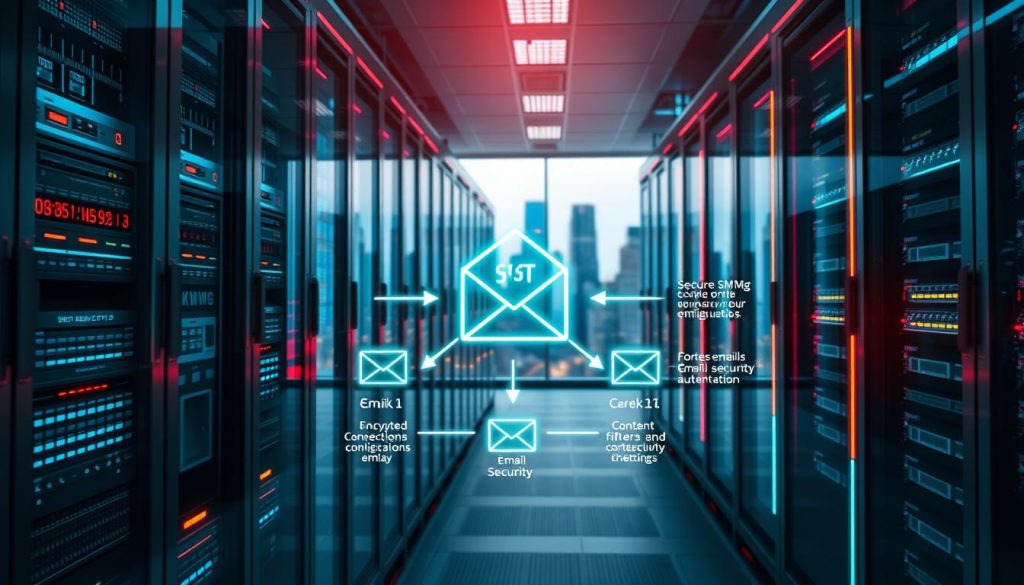In today’s world, keeping your mail infrastructure safe is key. A strong firewall is your first defense against cyber threats. It keeps your messages safe.
Cyberattacks are getting more common. So, securing your mail server is now more critical than ever. A good firewall keeps your data safe and stops unwanted access. This keeps your clients and stakeholders trusting you.
A well-set-up firewall is a must for any business that uses email. It blocks bad traffic and lowers the chance of data leaks.
Key Takeaways
- Understand the importance of a robust firewall for mail server security.
- Learn how to configure a firewall for optimal protection.
- Discover the benefits of securing your mail infrastructure.
- Identify potential threats to your mail server.
- Implement best practices for mail server security.
The Growing Threat Landscape for Email Servers
Email servers face many new cyber threats. As we use email more, hackers find new ways to attack.
Current Attack Vectors Targeting Mail Servers
Attackers use phishing campaigns, malware attachments, and exploit email protocol bugs. It’s key to use email security measures to fight these threats.
Statistics on Email Security Breaches
Many organizations have faced email security issues. This shows we need best practices in email server security.
Financial Impact of Mail Server Compromises
Mail server hacks can cost a lot. Costs include fixing problems, legal fees, and lost business.
Knowing these threats helps us protect email servers better.
Why Your Mail Server Firewall is Your First Line of Defense
A mail server firewall is the first defense against many email threats. It is key in keeping email services safe from cyber attacks.
The Critical Role of Firewalls in Email Infrastructure
Firewalls control network traffic by setting security rules. They block unwanted access and let in safe messages.
How Firewalls Prevent Common Email Attacks
Firewalls stop spam, phishing, and malware by checking traffic. They block bad IP addresses.
Case Studies: Before and After Firewall Implementation
Many companies improved their email security with a good firewall. For example, a bank cut spam by 80% by blocking spammer IP addresses.
| Security Measure | Before Firewall | After Firewall |
|---|---|---|
| Spam Emails | 1000/day | 200/day |
| Malware Incidents | 5/month | 0/month |
Setting up a firewall right can greatly boost email server security. It keeps threats away and keeps email services safe.
Types of Firewalls for Effective Mail Server Protection
Choosing the right firewall is key to secure your mail server. A secure email server setup starts with knowing the firewall options. These options help protect your email system.
Network-Based Firewall Solutions
Network-based firewalls sit between your mail server and the network. They control traffic based on security rules. They block unwanted access to your mail server.
Application-Level Gateway Firewalls
Application-level gateway firewalls, or proxy firewalls, check traffic at the application layer. They filter mail server traffic by specific protocols. This boosts mail server security protocols.
Next-Generation Firewalls (NGFW)
NGFWs mix traditional firewall features with advanced security. They do deep packet inspection and intrusion prevention. This gives better protection for mail servers.
Cloud-Based Firewall Services
Cloud-based firewall services offer scalable security for mail servers. They detect threats in real-time. They also fit well with cloud infrastructure, making your secure email server setup easy without hardware.
Knowing the different firewalls helps you choose the best for your mail server. Each type has its own benefits. You can pick one that fits your security needs and setup.
Essential Features of a Robust Mail Server Firewall
Email server protection needs a strong firewall. A good mail server firewall is key to keeping emails safe from cyber threats.
Advanced Threat Detection is a must in a mail server firewall. This means:
Deep Packet Inspection Capabilities
Deep Packet Inspection (DPI) checks packets for threats. It makes sure emails and attachments are safe.
Intrusion Detection and Prevention Systems
Intrusion Detection Systems (IDS) watch for bad network activity. With Intrusion Prevention Systems (IPS), they can stop threats fast.
Real-Time Monitoring and Alerting
Real-time monitoring keeps admins updated on server security. Alerts can warn teams of threats, helping them act quickly.
Automated Response Mechanisms
Automated responses can act fast when threats are found. They can isolate systems or block bad IP addresses, reducing harm.

A mail server firewall with these features boosts email security. It’s important to pick a firewall that fits today’s needs and tomorrow’s threats.
Step-by-Step Guide to Securing Mail Server with a Firewall
A good firewall is like a shield for your mail server. It keeps it safe from bad guys. To keep your mail server safe, you need to plan, set up, and watch it closely.
Initial Firewall Deployment Strategy
First, you need a plan for your firewall. Look at your network, find weak spots, and pick the best firewall for you. Decide if you need a hardware or software firewall.
Think about how much email you send, what kind of data you send, and if you need to follow rules. Knowing this helps you choose and set up your firewall right.
Configuring Basic Access Control Lists
Access Control Lists (ACLs) are key for your firewall. They decide who can get in and who can’t. Start by blocking everything and then let in what you need.
- Find out who needs to get to your mail server.
- Choose which email types (like SMTP) to let through.
- Block bad IP addresses or networks.
Testing Your Firewall Configuration
After setting up your firewall, test it well. Try different kinds of traffic and see how it handles them.
Try sending and getting emails, and try to get in with bad ways. Fix any problems you find by tweaking your rules.
Documenting Your Security Setup
Keeping records is very important for a safe mail server. Write down your firewall setup, any changes, and test results.
By following these steps and staying alert, you can make your mail server much safer from cyber threats.
Configuring SMTP Protection Through Your Firewall
Email security is key. It keeps spam and bad attacks away. A good firewall blocks threats from the internet.
Essential SMTP Port Configurations
SMTP uses port 25 for talking. Your firewall needs to watch this port. Also, ports 587 and 465 are important for mail and secure SMTP.
Implementing Connection Rate Limiting
Stopping brute-force attacks and spam is important. Your firewall can limit how many times an IP can connect in a short time.
SMTP Authentication Security Measures
SMTP login must be safe. Use SPF, DKIM, and DMARC to keep it secure.
Handling Encrypted SMTP Connections
For STARTTLS or SMTPS connections, your firewall must allow these ports. This keeps your emails safe.

With these steps, your email server gets much safer. It fights off many threats.
Securing POP3 and IMAP Services with Firewall Rules
Securing POP3 and IMAP services is key to keep emails safe. These protocols help get emails from servers. But, they can be targets for hackers.
POP3 Security Best Practices
Limit who can access POP3 by setting up firewall rules. Only allow connections from trusted IP addresses. If you don’t need POP3, turn it off. IMAP is safer and has more features.
IMAP-Specific Firewall Configurations
Make sure your firewall lets IMAP traffic through. This is for both non-encrypted and encrypted connections. Use firewall rules to only let trusted IP addresses in.
Enforcing Encrypted Connections Only
Make sure all POP3 and IMAP connections are encrypted. Set your firewall to only allow secure ports. This keeps your emails safe.
Monitoring Client Connection Patterns
Keep an eye on who is connecting to your email. This helps catch any security problems early.
| Protocol | Default Port | Secure Port |
|---|---|---|
| POP3 | 110 | 995 |
| IMAP | 143 | 993 |
Following these steps will make your POP3 and IMAP services much safer. This protects your emails from hackers and other threats.
Advanced Mail Server Firewall Techniques
Advanced mail server firewall techniques are key to fighting new threats. Email is a big target for hackers. So, it’s important to make your firewall stronger.
Implementing Geo-Blocking for High-Risk Regions
Implementing Geo-Blocking for High-Risk Regions
Geo-blocking stops your mail server from being accessed by certain places. This helps a lot by blocking attacks from risky areas. For example, if you’re in the U.S., block traffic from places known for hacking.
Behavioral Analysis for Threat Detection
Behavioral Analysis for Threat Detection
Behavioral analysis watches how traffic moves to spot odd behavior. It catches threats that other methods might miss. Your firewall can then act fast to stop problems.
Zero-Day Attack Protection Strategies
Zero-day attacks use new, unknown weaknesses. They’re hard to stop. But, advanced firewalls use tricks like sandboxing and predictive analytics to fight them.
Custom Rule Creation for Specific Threats
Custom rules let you make your firewall special for your needs. You can block bad IP addresses or certain email attachments. This makes your server safer.
- Keep your geo-blocking lists up to date with new threats.
- Always check and change your behavioral analysis rules to catch more threats.
- Use many ways to protect against zero-day attacks.
Regulatory Compliance and Mail Server Firewalls
Following rules is not just a must. It’s key to keeping your mail server safe. Companies need to make sure their email server firewalls follow rules to keep data safe and avoid trouble.
GDPR Requirements for Email Security
The General Data Protection Regulation (GDPR) has strict rules for data protection. To meet GDPR, email server firewalls need strong encryption, access controls, and security checks.
HIPAA Compliance for Healthcare Organizations
Healthcare groups in the U.S. must follow the Health Insurance Portability and Accountability Act (HIPAA). HIPAA says email server firewalls must keep health info safe and sound.
PCI DSS Considerations for Transaction Emails
The Payment Card Industry Data Security Standard (PCI DSS) is for groups that deal with credit card info. PCI DSS for emails means using firewalls and encryption right.
Documenting Compliance Measures
Keeping records of your compliance is very important. It helps show you follow the rules. This includes records of your email server firewalls, security plans, and how you handle problems.
Monitoring and Maintaining Your Mail Server Firewall
A good mail server firewall needs regular care. Keeping your email safe means you must always watch and update your firewall.
Establishing Regular Security Audit Procedures
It’s key to check your mail server firewall often. Do this at least every three months. Look at your firewall rules, who can access what, and if you have any intrusion detection systems.
Analyzing Firewall Logs Effectively
Firewall logs show you if you’re under attack. Use tools to watch these logs live. This helps spot security problems or attempts to get in. Using a log analysis tool helps a lot in finding and fixing threats.
Keeping Firewall Rules and Signatures Updated
Old firewall rules and signatures are not enough. You must update them often. This keeps your mail server safe from new dangers.
Responding to Security Incidents
If a security problem happens, you need a plan. This plan should include isolating the problem, investigating, and fixing it. Training your security team helps them act fast and well.
Conclusion: Building a Sustainable Mail Server Security Strategy
It’s very important to make your email server safe from new threats. Knowing how to protect your email server helps a lot. This way, you can lower the chance of security problems.
Having a good security plan means using a strong firewall and SMTP protection. Also, keep POP3 and IMAP safe and do security checks often. These steps help keep your emails safe and private.
Email is still a key way to talk to each other. So, it’s important to always be ready to fight off new threats. With a strong security plan, you can keep your email safe. This helps keep your organization’s trust with others.
FAQ
What is the primary function of a mail server firewall?
A mail server firewall controls network traffic. It follows security rules to keep the server safe. It stops unwanted access and threats.
How does a firewall prevent common email attacks?
Firewalls block bad traffic and filter out harmful emails. They limit access to certain IP addresses or ports. This protects against spam, phishing, and malware.
What are the key features to look for in a mail server firewall?
Look for deep packet inspection and intrusion detection. Also, real-time monitoring and alerting are important. Automated responses are key for strong security.
How often should I update my mail server firewall rules and signatures?
Update your firewall rules and signatures often. This keeps your server safe from new threats. Regular updates help your firewall stay effective.
Can a firewall alone secure my mail server?
A firewall is important but not enough. You need a full security plan. This includes encryption, secure protocols, and regular checks.
What is the role of SMTP protection in mail server security?
SMTP protection stops email attacks. Set up port configurations and connection limits. Use SMTP authentication to fight spam and threats.
How can I ensure my mail server complies with regulatory requirements?
Follow security measures for GDPR, HIPAA, and PCI DSS. Use your firewall to meet these standards. Keep records of your efforts.
What are the benefits of using a next-generation firewall (NGFW) for my mail server?
NGFWs have advanced features like deep packet inspection. They prevent sophisticated threats. This improves your email security.




The point about the growing threats to email servers is spot on. With so many different attack vectors out there, it’s easy to see why businesses need to prioritize mail server security. A strong firewall isn’t just about blocking bad traffic, it’s about protecting your entire reputation.
It’s easy to overlook the firewall when thinking about email security, but this post nails its importance. I’d also add that regularly updating firewall rules based on evolving threat intelligence can make a big difference.
Interesting point about the financial impact of server breaches. It’s easy to focus on the immediate security measures, but the long-term costs of a compromised server can be devastating.
The rise in phishing and malware attacks on email servers is really alarming. Configuring a firewall properly is definitely the best first step in securing these systems. It’s all about minimizing risk before anything happens.